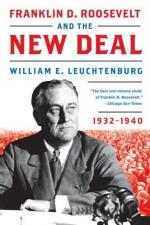
|
| Name: _________________________ | Period: ___________________ |
This test consists of 15 multiple choice questions and 5 short answer questions.
Multiple Choice Questions
1. How many deutsche marks are Jews in Germany fined by the Nazis after a young Polish Jew murders the third secretary of the German Embassy in Paris in November of 1938.
(a) 4 billion.
(b) 6 thousand.
(c) 500 thousand.
(d) 1 billion.
2. As "A Sea of Troubles" opens, on which of the following dates in 1937 does Roosevelt deliver his second Inaugural Address?
(a) February 19.
(b) January 7.
(c) January 21.
(d) February 5.
3. In "The Roosevelt Reconstruction: Retrospect" which of the following composers cancels a Pittsburgh performance because the theater owners are violating a union contract?
(a) Richard Strauss.
(b) Leopold Stokowski.
(c) Oleg Caetani.
(d) Aaron Copeland.
4. During the review of Roosevelt's Presidency, Leuchtenburg notes that how many trees were planted as a windbreak under Roosevelt?
(a) 150 thousand.
(b) 200 million.
(c) 800 billion.
(d) 600 thousand.
5. Which of the following individuals is the leader of the New Deal faction in the House of Representatives in 1937?
(a) Josiah Bailey.
(b) Harry Byrd.
(c) Maury Maverick.
(d) Carter Glass.
6. In 1936 Roosevelt speaks at the Democratic Convention in Philadelphia. As he makes his way onto the stage, he falls while trying to shake the hand of which individual?
(a) Edwin Markham.
(b) Anne O'Hare McCormick.
(c) Roy Howard.
(d) William Phillips.
7. In response to Roosevelt's April request for a large-scale lend-spend program, in June 1938 Congress votes to approve how much for public works?
(a) $9.4 trillion.
(b) $3.75 billion.
(c) $860 thousand.
(d) $640 thousand.
8. In September of 1935, which of Roosevelt's political critics is shot and killed by Dr. Carl Austin Weiss?
(a) Doctor Townsend.
(b) Rev. Coughlin.
(c) Dean Acheson.
(d) Huey Long.
9. On October 11, 1938, Roosevelt announced a build up for how much to American armaments, a response to a speech by Hitler?
(a) $300 million.
(b) $500 thousand.
(c) $600 billion.
(d) $250 million.
10. Which of the following individuals is the US ambassador to Germany in "A Farewell to Arms" and says that Hitler is such a horror that he cannot endure the man's presence?
(a) William Dodd.
(b) Frederick L. Schuman.
(c) Henry Stimson.
(d) George Messersmith.
11. Which of the following individuals is chairman of the House Committee on Un-American Activities when it is created in 1938?
(a) Frank Murpy.
(b) Noah Mason.
(c) James A. Farley.
(d) Martin Dies.
12. Shortly after his January 1938 State of the Union Address Roosevelt meets with the head of U.S. Steel. What was his name?
(a) Arthur Salter.
(b) Robert Jackson.
(c) Leon Henderson.
(d) Myron Taylor.
13. Which of the following individuals takes care of all White House mail up until Roosevelt's presidency?
(a) Erwin Canham.
(b) Frances Perkins.
(c) Justin Douglas.
(d) Ira Smith.
14. The loss of which pilot at sea causes the "New Republic" publication to ask that the government prevent citizens from engaging in this sort of useless exploit?
(a) Amelia Earhart.
(b) Howard Hughes.
(c) Wilbur Wright.
(d) Charles Lindbergh.
15. In "The Roosevelt Reconstruction: Retrospect," which of the following Supreme Court Justices writes Roosevelt that he's of course made mistakes, but that's human?
(a) James McReynolds.
(b) Stanley Reed.
(c) John Clarke.
(d) Frank Murphy.
Short Answer Questions
1. On Memorial Day in 1937, in which of the following cities do police kill ten strikers at a steel plant?
2. Twice a week, during Roosevelt's press conferences, how many reporters were typically let in to question him?
3. Which of the following individuals comments toward the end of "A Sea of Troubles" that the "old Roosevelt magic has lost its kick"?
4. The exploits of which of the following individuals in 1933 and 34 convinces Americans that better federal action was needed in law enforcement?
5. "An End to Isolation" states that by the end of 1940 America has worked out defense agreements with all but which of the South American nations?
|
This section contains 572 words (approx. 2 pages at 300 words per page) |

|




